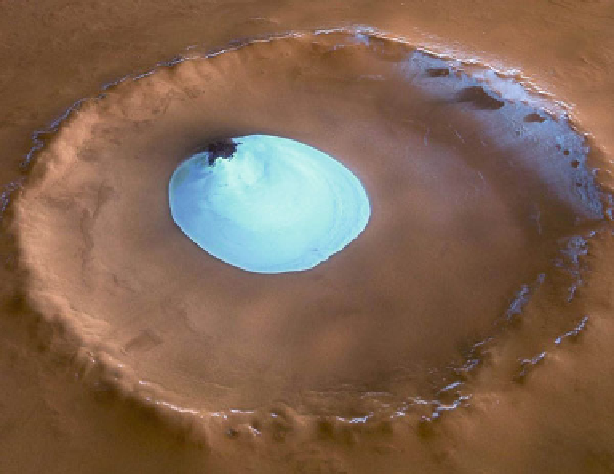Geoscience Reference
In-Depth Information
Fig. 8.9
The European Space Agency's (ESA) Mars Express Orbiter robotic spacecraft obtained
this view of an unnamed impact crater located on Vastitas Borealis, a broad plain that cov-
ers much of Mars' far northern latitudes. The circular patch of bright material located at
the center of the crater is residual water ice. The colors are very close to natural, but the
vertical relief of the topography is exaggerated three times. This patch of ice is present all
year round, remaining after frozen carbon dioxide overlaying; it disappears during the Martian
gallery_read-Image.8.5131/
- Image credit: ESA/DLR/FU Berlin, July 28, 2005)
lava and produces such rootless cones. These features can be found, for example,
in Athabasca Vallis, associated with lava flowing along this outflow channel. Larger
cones may be made when the steam passes through thicker layers of lava (Fig.
8.9
).
8.3.5.5
Scalloped Topography
Certain regions of Mars display scallop-shaped depressions. The depressions are
suspected to be the remains of a degrading ice-rich mantle deposit. Scallops are
caused by ice sublimating from frozen soil. This mantle material was probably
deposited from the atmosphere as ice formed on dust when the climate was different
due to changes in the tilt of the Mars pole (please see the subitem “Ice Ages,”
below). The scallops are typically tens of meters deep and from a few hundred to a
few thousand meters across. They can be almost circular or elongated.
Some appear to have coalesced causing a large heavily pitted terrain to form.
The process of forming the terrain may begin with sublimation from a crack. There
are often polygonal cracks where scallops form, and the presence of scalloped
topography seems to be an indication of frozen ground.

Search WWH ::

Custom Search